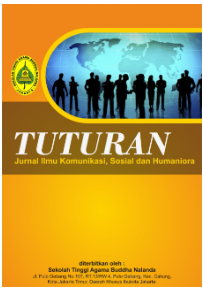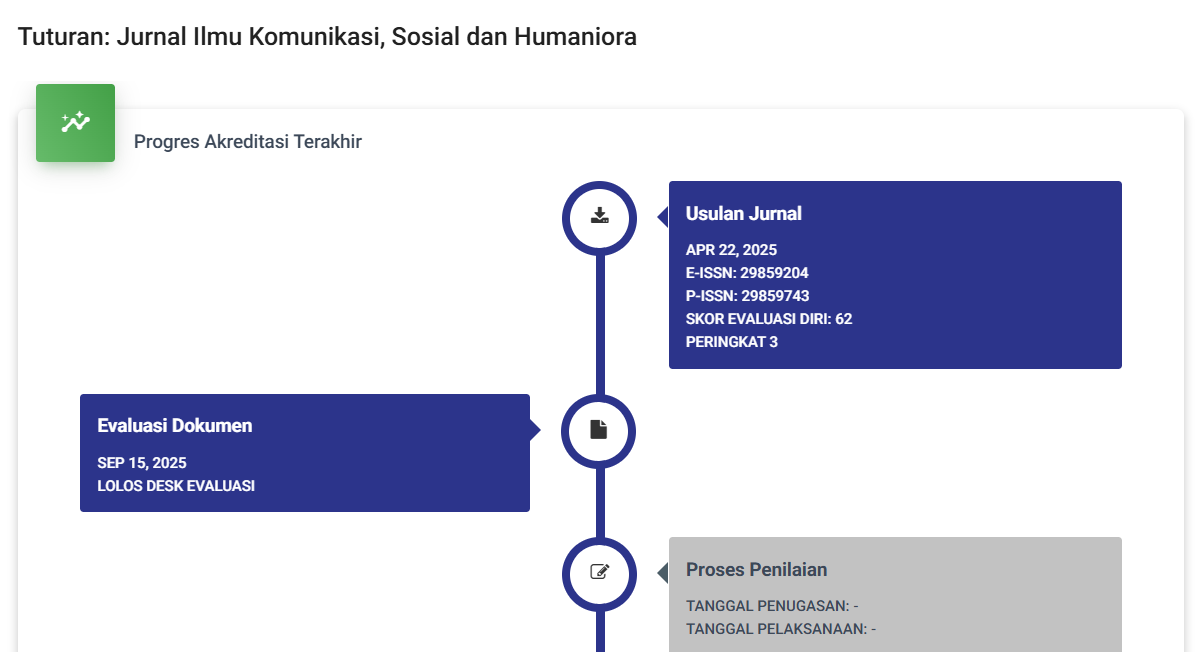Representasi Oksidentalisme dalam Film Gintama (2017)
DOI:
https://doi.org/10.47861/tuturan.v3i2.1428Keywords:
Gintama, Japan, Occidentalism, Representation, WestAbstract
Movies can influence audiences' perceptions of foreigners who are a minority group in society. There are positive and negative views of Westerners formed in Japanese films. The live-action movie “Gintama” uses the historical setting of Japan in the Bakumatsu period where Western countries succeeded in forcing Japan to open relations with foreign countries. This study attempted to determine the representation of occidentalism in Gintama movie. Using a qualitative descriptive research method that relies on Roland Barthes' semiotic analysis, this study analyzed the representation of occidentalism in this film through stages of analysis at the denotation level and connotation level. The analysis process involved documentation as a data collection technique. The results of the study showed the existence of denotative and connotative meanings that represent occidentalism in the historical story of Japan during the Bakumatsu period that is presented in this film. The results of the study indicated that occidentalism in the film Gintama is in accordance with the concept of occidentalism explained by Ian and Buruma where the West tends to be viewed negatively while Japan tends to be depicted positively.
References
Abdedaim, K. (2024). Occidentalism revisited: A dual perspective on the image of the Other (Western). Algerian Scientific Journal Platform, 28(78), 1062-1071. https://www.asjp.cerist.dz/en/downArticle/90/28/4/246648
Altun, H. (2015). US public diplomacy in the modern era: A review of battles to bridges. All Azimuth: A Journal of Foreign Policy and Peace, 4(2), 53-62. https://doi.org/10.20991/allazimuth.167338
Barthes, R. (1983). Mythologies. London: Methuen.
Bauhn, P., & Tepe, F. F. (2017). Turkish Occidentalism and representations of Western women in Turkish media. İleti-ş-im, Galatasaray University Journal of Communication, (26), 65-82. https://doi.org/10.16878/gsuilet.324193
Buruma, I., & Margalit, A. (2004). Occidentalism: The West in the eyes of its enemy. New York: The Penguin Press.
Christiani, L. C. (2017). Representasi identitas etnis Papua dalam serial drama remaja Diam-diam suka. Jurnal Komunikasi dan Kajian Media, 1(1), 15-30. https://jurnal.untidar.ac.id/index.php/komunikasi/article/view/387/348
Daldal, A. (2018). Two oriental images of Istanbul: Robbe-Grillet’s L’Immortelle and Erksan’s Time to Love. European Journal of Turkish Studies, 2018, 1-18. https://doi.org/10.4000/ejts.5590
Debito, A. (2007). Gaijin Hanzai Magazine and hate speech in Japan: The newfound power of Japan’s international residents. Japan Focus: The Asia-Pacific Journal, 5(3), 1-18. https://apjjf.org/arudou-debito/2386/article
Fiske, J. (2007). Cultural and communication studies: Sebuah pengantar paling komprehensif. Yogyakarta: Jalasutra.
Halse, L. (2018). West above the rest: Investigating the depiction of Caucasian western characters in Japanese cinema. Lund: Lund University.
Heurtebise, J.-Y. (2023). Green Orientalism, brown Occidentalism, and Chinese ecological civilization: Deconstructing the culturalization of the Anthropocene to nurture transcultural environmentalism. Asian Studies, University of Ljubljana Press, Slovenia, 11(2), 119-148. https://doi.org/10.4312/as.2023.11.2.119-148
Jones, N. C. (2023). Betty Shamieh's The Black Eyed: An Arab-American woman playwright inverts and subverts Orientalism. Athens Journal of Humanities & Arts, 11(2), 155-170. https://doi.org/10.30958/ajha.11-2-3
Jouhki, J., & Pennanen, H. R. (2016). The imagined West: Exploring Occidentalism. Suomen Antropologi, 41(2), 1-10. http://ojs.tsv.fi/index.php/suomenantropologi/article/view/59639
Melani, A. (2017). Liputan 6: Jumlah pekerja asing capai 1 juta di Jepang. Available at: https://m.liputan6.com/bisnis/read/2842816/jumlah-pekerja-asing-capai-1-juta-di-jepang, diakses tanggal 24 November 2019.
Metin, A. (2020). Occidentalism: An Eastern reply to Orientalism. Bilig – Journal of Social Sciences of the Turkic World, (93), 181-202. https://doi.org/10.12995/bilig.9308
Metin, A. (2021). West of ISIS: A discourse and operation analysis from Occidentalist perspective. Security, Terrorism and Society, (13), 29-51. https://www.sicurezzaterrorismosocieta.it/issue-13-2021/?lang=en
Muharram, M. A. H. (2014). Occidentalism/Orientalism in reverse: The West in the eyes of modern Arab intellectuals. Journal of American Studies of Turkey, (39), 43-54. https://dergipark.org.tr/en/pub/jast/issue/52974/700799
Pineda, R. A. (2017). Anime News Network: Gintama live-action film gets sequel in summer 2018. Available at: https://www.animenewsnetwork.com/news/2017-11-16/gintama-live-action-film-gets-sequel-in-summer-2018/.124105, diakses tanggal 16 Oktober 2020.
Sarwoto, P. (2018). A Javanese view on America in the 60s: Umar Kayam and the Manhattan stories. International Journal of Diaspora & Cultural Criticism, 8(1), 11-34.
Sezer, E. (2019). The Japan Times: Non-Japanese people are poorly represented in Japanese media: That needs to change. Available at: https://www.japantimes.co.jp/community/2019/03/17/voices/non-japanese-people-poorly-represented-japanese-media-needs-change/, diakses tanggal 9 November 2020.
Sobur, A. (2001). Analisis teks media: Suatu pengantar untuk analisis wacana, analisis semiotik, dan analisis framing. Bandung: PT Remaja Rosdakarya.
Stam, R., et al. (1998). New vocabularies in film semiotics: Structuralism, post-structuralism and beyond. London: Routledge.
Downloads
Published
How to Cite
Issue
Section
License
Copyright (c) 2025 TUTURAN: Jurnal Ilmu Komunikasi, Sosial dan Humaniora

This work is licensed under a Creative Commons Attribution 4.0 International License.








